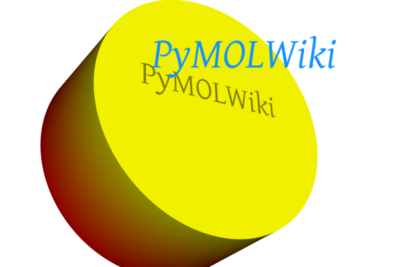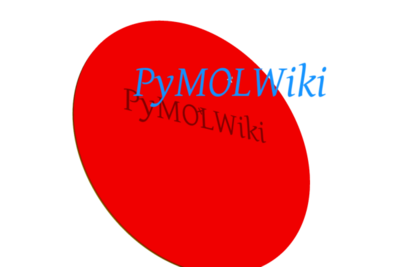CGOCylinder
Appearance
Overview
CGO cylinders are compiled graphics cylinder objects. If you set the cylinder height to something very small, you can mimic a circle (see examples).
-
Example cylinder and label. The label was added as a label on a Pseudoatom.
-
Cylinder with a very thin cyilnder, here 0.2 Angstroms tall to mimic a circle. The label was added as a label on a Pseudoatom.
Examples
# Cylinder #1 on left.
x1,y1,z1 = 10, 0, 0 # start point
r1,g1,b1 = 1,0,0 # color (red)
x2,y2,z2 = 0.1, 0, 0 # end point
r2,g2,b2 = 1,1,0 # color (yellow)
radius = 10
cmd.load_cgo( [ 9.0, x1, y1, z1, x2, y2, z2, radius, r1, g1, b1, r2, g2, b2 ], "cylinder1" )
# Cylinder #2 (the circle)
x1,y1,z1 = -0.1, 0, 0 # start point
r1,g1,b1 = 1,0,0 # color (red)
x2,y2,z2 = 0.1, 0, 0 # end point
r2,g2,b2 = 1,1,0 # color (yellow)
radius = 10
cmd.load_cgo( [ 9.0, x1, y1, z1, x2, y2, z2, radius, r1, g1, b1, r2, g2, b2 ], "cylinder2" )
# to make the cylinder transparent, use
cmd.load_cgo( [ 25.0, 0.25, 9.0, x1, y1, z1, x2, y2, z2, radius, r1, g1, b1, r2, g2, b2 ], "cylinder1" )
Usage
cmd.load_cgo( [ a1, a2, cylSpec, x1, y1, z1, x2, y2, z2, radius, r1, g1, b1, r2, g2, b2 ], objName )
The parameters are:
a1, a2
- a1=25 means 'ALPHA' (if you do from pymol.cgo import * you can then use CGO keywords, like ALPHA, CYLINDER, etc. So, if a1="25.0" then set a2 to some value in the range 0-1.
cylSpec
- Cylinder specification: set this to 9.0 or if you did from pymol.cgo import * you can then use "CYLINDER", here.
x1, y1, z1
- coordinates for one end of the cylinder
x2, y2, z2
- coordinates for one end of the cylinder
radius
- radius of the cylinder
r1, b1, g1
- color one, (a triplet of values in the range 0-1
r2, b2, g2
- color two, (a triplet of values in the range 0-1; this allows a gradient
objName
- Name of cylinder object in PyMOL
References
PyMOL list. Thanks to Tsjerk.

